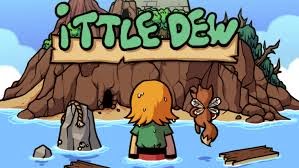Let's talk about clones. The videogame industry is full of them. Every genre has its share of games that borrow ideas from others. In fact, videogame genres themselves only exist because of this. Pong lead to Breakout and Arkanoid, Space Invaders evolved into the shooter/bullet hell scene, Donkey Kong launched the entire platformer genre, and Pac-Man inspired the top down maze adventures that eventually morphed into first person shooters. Think about that next time you load up Bioshock or Borderlands, you're really just playing a more advanced game of Pac-Man.
One of those top down maze games that evolved out of our favorite yellow muncher was the 1979 title Adventure for the Atari 2600, itself a console port of the 1977 text adventure Colossal Cave Adventure. The console/PC differences were much more noticeable back in the 70s. Adventure's dragons, bats, castles, and forests directly inspired the 1986 Famicom/NES mega-hit The Legend of Zelda, which in addition to launching one of gaming's most respected and successful franchises ever, also launched a huge number of clones. Early examples include StarTropics for the NES, Neutopia for the TurboGrafx-16, and Landstalker for the Mega Drive/Genesis. Later examples include Beyond Good & Evil and the Darksiders series. Even today, designers continue to pay direct tribute to the early Zelda games with releases such as 3D Dot Game Heroes, The Binding of Isaac, Evoland, and the subject of this review: Ittle Dew.
Ittle Dew doesn't hold back with its obvious influences. The visual style is Link to the Past with Wind Waker's cartooniness, the opening cinematic is right out of Link's Awakening, and there's even a fairy winged companion as in Ocarina of Time and Majora's Mask. Not even the display misses out on fun featuring such familiar Zelda tropes as heart containers collected in quarters.
The plot is fairly simple. Green tunic clad adventurer Ittle Dew and her fairy/fox sidekick Tippsie are shipwrecked on a mysterious island, and need a way to escape. The only raft available is in the shop of a man named Item Carver, who happens to carve items. Will he generously donate his raft to the cause out of the goodness of his heart? Oh coarse not! First, you must go on a quest or two.
In classic Zelda style, Ittle Dew is comprised of an overworld and dungeons. As with Phantom Hourglass, there is a main dungeon that must be repeatedly visited throughout the game between trips to the others. Items are collected in the smaller dungeons which allow you to proceed farther in the larger one, which is where you collect the gold needed to purchase passage to the smaller dungeons. It's the type of back and forth mechanic that could get old in a longer game, but Ittle Dew's brevity prevents that from becoming an issue.
While not as long as most adventure games, it does provide more replay value than would be expected. Taking more from Megaman than Zelda, Ittle Dew's levels can be approached in whatever order the player chooses. This effects what items are available when playing through the other dungeons, which of coarse effects what secrets and treasures are available. Playing through a second time in a different order can provide for a much different experience. Also, a quick trip to youtube shows how popular this game has become for speed runs!
Ittle Dew's dialog is dripping with humor and sarcasm. In addition to pulling inspiration from, and paying tribute to the Zelda franchise, it also pulls no punches in poking fun at many of the genre's standard tropes. The way you refill your health by picking up a heart, the basic interaction with the enemy creatures, even the nature of the quests themselves, when taken a look at from a step back can seem a little silly. The eye winks and rib jabs stay upbeat and fun without getting annoying, which is always a risk when taking this sort of satirical approach to a game's narrative.
Ittle Dew is more than a series of cutscenes though. There's questing to be done! The gameplay itself is combination of combat and puzzle solving. The basic combat as you traverse the island's various locals is adequate, but nothing really special. As you gather more of the game's special items and begin to discover more creative methods of dispensing the different creatures the fighting starts to get more interesting, but overall the combat isn't the main draw of this game. The boss battles do kick it up a notch though by forcing you to figure out how to use your new items to turn the enemy's attacks back on itself.
The puzzles are where Ittle Dew really shines. While some games still have trouble figuring out interesting ways to challenge your mind while adventuring, Ludosity has created some surprisingly inspired brain teasers to work your way through while on your quest to escape the island. Much of it is taken directly from Zelda canon such as lighting and extinguishing torches, striking magic crystals, and bombing through boulders and cracked rocks, but these concepts are all expanded upon to a degree that really raises the mental challenge to a new level. Some of the puzzles span multiple rooms that must be traversed in just the right order to make everything lined up, all while fighting off the dungeon's inhabitants of coarse.
While Ittle Dew might not be a great game, I had a great time playing it. It might not be a timeless classic, but it's a game that I would highly recommend to any fans of the classic Zelda games, especially because it's available on so many different platforms at this point. According to the Ludosity website, there's a sequel in the works too, so I'll definitely be keeping an eye out for that!



.jpeg)






No comments:
Post a Comment